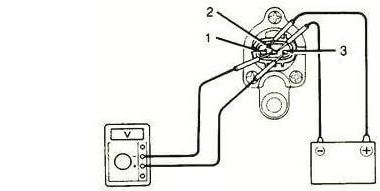
How to check the speed sensor
Content
If ICE stalls at idle, then, most likely, you will need to check several sensors (DMRV, DPDZ, IAC, DPKV) in order to determine the culprit. Earlier we looked at verification methods:
- crankshaft position sensor;
- throttle position sensor;
- idle sensor;
- mass air flow sensor.
Now a do-it-yourself speed sensor check will be added to this list.
In the event of a breakdown, this sensor transmits erroneous data, which leads to a malfunction of not only the internal combustion engine, but also other components of the car. The vehicle speed meter (DSA) sends signals to a sensor that controls the operation of the motor at idle, and also, using the PPX, controls the air flow that bypasses the throttle. The higher the vehicle speed, the higher the frequency of these signals.
The principle of operation of the speed sensor
The speed sensor device of most modern cars is based on the Hall effect. In the process of its operation, it is transmitted to the car's computer with pulse-frequency signals at short intervals. namely, for one kilometer of the way, the sensor transmits about 6000 signals. In this case, the frequency of impulse transmission is directly proportional to the speed of movement. The electronic control unit automatically calculates the speed of the vehicle based on the frequency of the signals. It has a program for this.
it is the speed sensor that is located next to the gearbox, namely, in the speedometer drive mechanism. The exact location is different for different brands of cars.
How to determine if the speed sensor is not working
You should immediately pay attention to such signs of breakdown as:
- there is no idle stability;
- the speedometer does not function correctly or does not function at all;
- increased fuel consumption;
- reduced engine thrust.
also, the on-board computer may give an error about the absence of signals on the DSA. Naturally, if the BC is installed on the car.
Speed sensor
Location of the speed sensor
Most often, a breakdown is caused by an open circuit, therefore, first of all, it is necessary to diagnose its integrity. First you need to disconnect the power and inspect the contacts for oxidation and dirt. If it is, then you need to clean the contacts and apply Litol.
Often wires break near the plug, because that's where they bend and the insulation can fray. you also need to check the resistance in the ground circuit, which should be 1 ohm. If the problem has not been resolved, then it is worth checking the speed sensor for operability. Now the question arises: how to check the speed sensor?
On VAZ cars, and on others too, a sensor is often installed that works according to the Hall effect (usually it gives out 6 pulses in one full revolution). But there is also sensors of a different principle: reed and inductive... Let us first consider the verification of the most popular DSA - based on the Hall effect. It is a sensor equipped with three pins: ground, voltage and pulse signal.
Checking the speed sensor
First you need to find out if there is grounding and a voltage of 12 V in the contacts. These contacts are ringed and the pulse contact is torsion tested.
Method 1 (check with a voltmeter)
- We dismantle the speed sensor.
- We use a voltmeter. We find out which terminal is responsible for what. We connect the incoming contact of the voltmeter to the terminal that outputs pulse signals. The second contact of the voltmeter is grounded on the internal combustion engine or the car body.
- Rotating the speed sensor, we determine are there signals in the duty cycle and measure the output voltage of the sensor. In order to do this, you can put a piece of tube on the axis of the sensor (turn at a speed of 3-5 km / h.) The faster you rotate the sensor, the higher the voltage and frequency in the voltmeter should be.
Method 2 (without removing from the car)
- We install the car on a rolling jack (or a regular telescopic one) so that something one wheel did not touch the surface of the earth.
- We connect the sensor contacts with a voltmeter.
- We rotate the wheel and diagnose whether voltage appears - if there is voltage and frequency in Hz, then the speed sensor works.
Method 3 (check with control or light)
- Disconnect the impulse wire from the sensor.
- Using the control, we are looking for “+” and “-” (preliminarily turning on the ignition).
- We hang one wheel as in the previous method.
- We connect the control to the “Signal” wire and turn the wheel with our hands. If “-“ is lit on the control, then the speed sensor is working.
Wiring diagram
DS check with a tester
Checking the speed sensor drive
- We raise the car on a jack in order to hang out any front wheel.
- We are looking for a sensor drive that sticks out of the box with our fingers.
- Rotate the wheel with your foot.
Speed sensor drive
Checking the DC drive
With our fingers we feel whether the drive is working and whether it is stable. If not, then we disassemble the drive and usually find damaged teeth on the gears.
Reed switch DS test
The sensor generates signals in the form of rectangular pulses. The cycle is 40-60% and the switching is from 0 to 5 volts or from 0 to battery voltage.
Induction DS test
The signal that comes from the rotation of the wheels, in fact, resembles the oscillation of a wave impulse. Therefore, the voltage changes depending on the rotational speed. Everything happens in the same way as on the crankshaft angle sensor.
